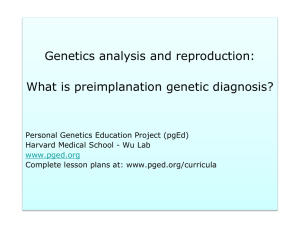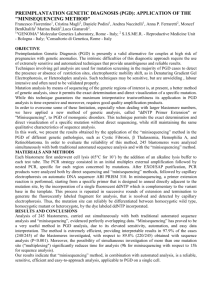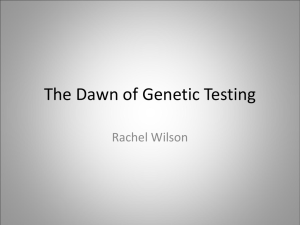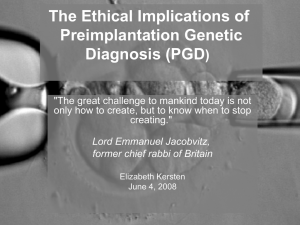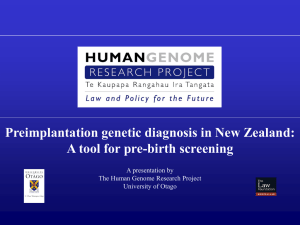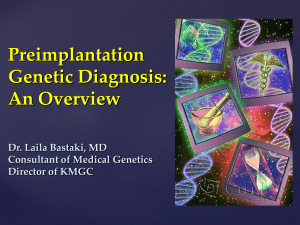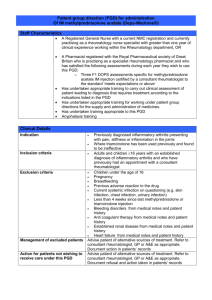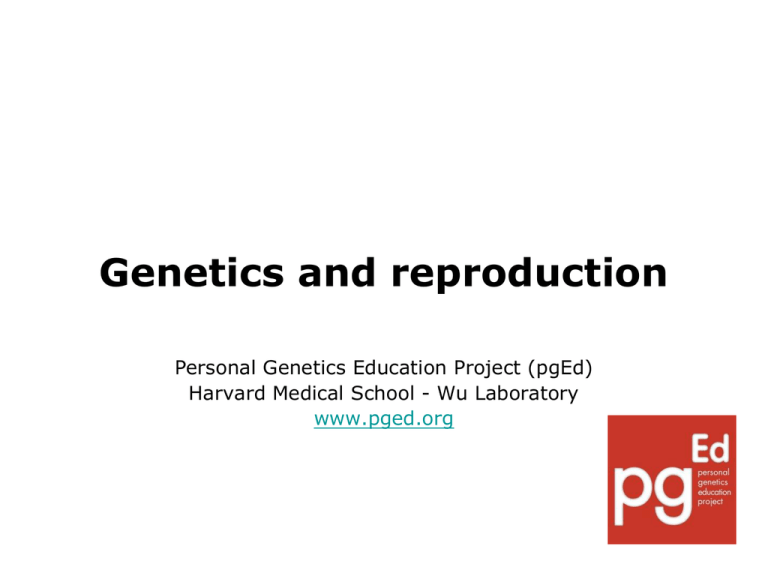
Genetics and reproduction
Personal Genetics Education Project (pgEd)
Harvard Medical School - Wu Laboratory
www.pged.org
Discussion questions:
• If you could choose specific traits or qualities
that you would want your child to have, what
would you choose? Why?
• Are there traits you would not want your child
to have? What are they? Why?
Genetic reproductive technologies
can be used to:
• Gain genetic information about an embryo or
unborn fetus.
• Help individuals conceive.
• Allow individuals to select embryos based on their
genetic makeup.
Prenatal testing
Invasive testing: Amniocentesis and chorionic villus sampling
Non-invasive prenatal testing
(NIPT)
•Fetus and mother
share a blood
supply.
•Fetal cells release
DNA, which can
then enter the
maternal blood
stream.
•Maternal blood now
contains a mixture
of fetal cell-free
DNA and maternal
cell-free DNA.
http://www.monashultrasound.com.au/images/NIPT_clip_image003.jpg
http://www.nature.com/news/researchers-turn-off-down-s-syndrome-genes-1.13406
What is in vitro fertilization (IVF)?
• In vitro fertilization is a technique used to treat infertility.
• A woman has eggs harvested from her ovaries, after
taking hormones to stimulate egg production. The eggs
are then combined with sperm in a petri dish.
• After 3-5 days, the embryos are assessed, and a
doctor/embryologist determines which embryos are of the
highest quality.
• One or more embryos are then placed in the woman’s
uterus. The embryo(s) may or may not attach and lead to
pregnancy.
What is preimplantation genetic
diagnosis (PGD)?
• The embryo is created via in vitro fertilization.
• Typically, a single cell is removed from the embryo at the
8-cell stage (3 days after fertilization).
• Genetic testing is performed.
• The results of testing are used to decide which embryos,
if any, to implant in the prospective mother’s uterus.
PGD:
Pre-implantation Genetic Diagnosis
Schwartz 2011
Jewish News
A Real Family impacted by PGD:
Molly and Adam Nash
Fanconi anemia (disorder of DNA repair)
Cure: PGD, umbilical cord blood
stem cells
http://tvnoviny.sk/sekcia/spravy/zahranicne/vo-francuzsku-sa-narodilo-prve-dizajnerske-dieta.html
What % of IVF clinics provide testing for the following reasons?
aneuploidy
autosomal disorders
chromosomal rearrangement
X-linked diseases
non-medical sex selection
avoid adult-onset disease
HLA typing
HLA typing w/o single gene test
Select for a disability
http://www.dnapolicy.org/resources/GeneticTestingofEmbryos.pdf
Public attitudes regarding acceptable uses of PGD:
Fatal
HLA match Adult
Sex Intelligence/
onset disease
strength
http://www.dnapolicy.org/resources/2006_Hudson_PGD_public_policy_and_public_attitudes.pdf
Opinion poll: What role, if any, should the
government of the United States play in
regulating PGD?
Want a total ban
on PGD
Support no
government
regulation
Think government
should regulate
ethics
only
Support
government
regulation of
safety and
quality
Believe
government
should regulate
safety, quality
and ethics
http://www.dnapolicy.org/resources/2006_Hudson_PGD_public_policy_and_public_attitudes.pdf
Discussion Questions
• What are the potential opportunities that PGD
can provide and what are the challenges of PGD?
• Now that you have discussed PGD, have you
changed your opinion about whether you would
want to choose certain traits for your child?
• If your parents had applied PGD to you, should
they tell you? Or would you prefer not to know?
• Do we need rules to guide how PGD is used? If
yes, what sort of rules? Whose job would it be to
make and enforce such rules?

